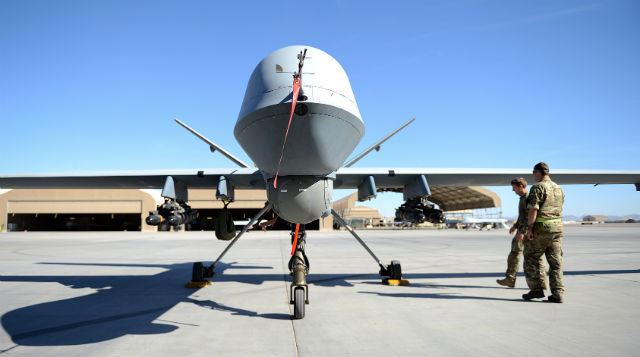The UK has yet to formally accept delivery of its extra batch of five General Atomics Aeronautical Systems Reaper air vehicles, which will double the Royal Air Force’s fleet of the type for operations inside Afghanistan.
“We are waiting on the delivery of the air vehicles, which are in final acceptance, but all the other elements, such as the training, people and [ground control station] cabins are in place,” says Wg Cdr Damian Killeen, officer commanding the RAF’s 13 Sqn. “We are expecting that they’ll be delivered in the early days of 2014,” he said during a media event at the unit’s Waddington home in Lincolnshire on 15 January.

Crown Copyright
A fleet of five Reapers operated by the RAF’s 13 and 39 squadrons are currently capable of providing a combined maximum of 36h of intelligence, surveillance, target acquisition and reconnaissance service per day from Kandahar airfield, with individual sorties lasting up to 16h. The additional aircraft now pending delivery will lift this capacity to 72h.
Used since late 2007, the RAF’s Reaper remotely piloted air systems (RPAS) have now amassed more than 54,000 flight hours in Afghanistan, operating predominantly over Helmand Province in a reconnaissance role. The UK’s only such armed equipment, the type’s remote crews have also to date released some 459 precision-guided weapons.
Now being flown using urgent operational requirement funding, the Reaper fleet is planned to be retained beyond the combat phase of the NATO-led International Security Assistance Force mission, and brought within the MoD’s core equipment budget. The RAF also plans to retain an element of its current 39 Sqn personnel presence at the US Air Force’s Creech AFB in Nevada, in order to sustain its existing RPAS relationship with the service and perform training activities.
“We have every intention of continuing to utilise Reaper beyond Afghanistan,” says RAF Air Vice-Marshal Philip Osborn, director of capability for the UK’s Joint Forces Command. “You will see us plan to bring Reaper more into an expeditionary, rather than deployed mode, and over the next few years we will shift from Reaper into the Scavenger programme, [which] should be capable of doing far more, on a worldwide basis.”
Source: Flight International
















